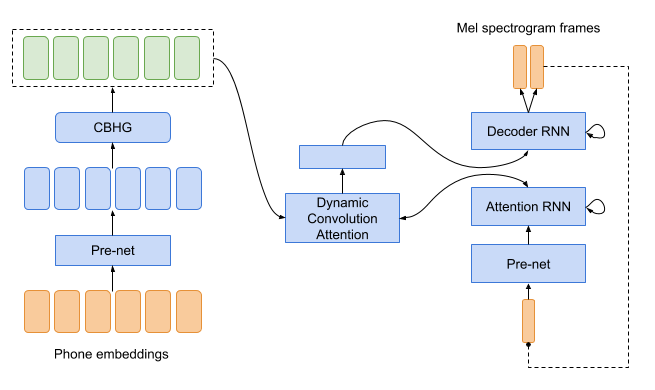Ecosyste.ms: Awesome
An open API service indexing awesome lists of open source software.
https://github.com/bshall/tacotron
A PyTorch implementation of Location-Relative Attention Mechanisms For Robust Long-Form Speech Synthesis
https://github.com/bshall/tacotron
attention-mechanism pytorch speech-synthesis tacotron text-to-speech tts
Last synced: 10 days ago
JSON representation
A PyTorch implementation of Location-Relative Attention Mechanisms For Robust Long-Form Speech Synthesis
- Host: GitHub
- URL: https://github.com/bshall/tacotron
- Owner: bshall
- License: mit
- Created: 2020-11-02T13:48:16.000Z (over 4 years ago)
- Default Branch: main
- Last Pushed: 2020-12-02T15:30:22.000Z (about 4 years ago)
- Last Synced: 2025-01-31T19:11:11.382Z (21 days ago)
- Topics: attention-mechanism, pytorch, speech-synthesis, tacotron, text-to-speech, tts
- Language: Python
- Homepage: https://bshall.github.io/Tacotron/
- Size: 1.01 MB
- Stars: 113
- Watchers: 2
- Forks: 24
- Open Issues: 6
-
Metadata Files:
- Readme: README.md
- License: LICENSE
Awesome Lists containing this project
README
# Tacotron with Location Relative Attention
A PyTorch implementation of [Location-Relative Attention Mechanisms For Robust Long-Form Speech Synthesis](https://arxiv.org/abs/1910.10288). Audio samples can be found [here](https://bshall.github.io/Tacotron/). Colab demo can be found [here](https://colab.research.google.com/github/bshall/Tacotron/blob/main/tacotron-demo.ipynb).

Fig 1:Tacotron (with Dynamic Convolution Attention).

Fig 2:Example Mel-spectrogram and attention plot.
## Quick Start
Ensure you have Python 3.6 and PyTorch 1.7 or greater installed. Then install this package (along with the [univoc vocoder](https://github.com/bshall/UniversalVocoding)):
```
pip install tacotron univoc
```
## Example Usage
```python
import torch
import soundfile as sf
from univoc import Vocoder
from tacotron import load_cmudict, text_to_id, Tacotron
# download pretrained weights for the vocoder (and optionally move to GPU)
vocoder = Vocoder.from_pretrained(
"https://github.com/bshall/UniversalVocoding/releases/download/v0.2/univoc-ljspeech-7mtpaq.pt"
).cuda()
# download pretrained weights for tacotron (and optionally move to GPU)
tacotron = Tacotron.from_pretrained(
"https://github.com/bshall/Tacotron/releases/download/v0.1/tacotron-ljspeech-yspjx3.pt"
).cuda()
# load cmudict and add pronunciation of PyTorch
cmudict = load_cmudict()
cmudict["PYTORCH"] = "P AY1 T AO2 R CH"
text = "A PyTorch implementation of Location-Relative Attention Mechanisms For Robust Long-Form Speech Synthesis."
# convert text to phone ids
x = torch.LongTensor(text_to_id(text, cmudict)).unsqueeze(0).cuda()
# synthesize audio
with torch.no_grad():
mel, _ = tacotron.generate(x)
wav, sr = vocoder.generate(mel.transpose(1, 2))
# save output
sf.write("location_relative_attention.wav", wav, sr)
```
## Train from Scatch
1. Clone the repo:
```
git clone https://github.com/bshall/Tacotron
cd ./Tacotron
```
2. Install requirements:
```
pipenv install
```
3. Download and extract the [LJ-Speech dataset](https://keithito.com/LJ-Speech-Dataset/):
```
wget https://data.keithito.com/data/speech/LJSpeech-1.1.tar.bz2
tar -xvjf LJSpeech-1.1.tar.bz2
```
4. Download the train split [here](https://github.com/bshall/Tacotron/releases/tag/v0.1) and extract it in the root directory of the repo.
5. Extract Mel spectrograms and preprocess audio:
```
pipenv run python preprocess.py path/to/LJSpeech-1.1 datasets/LJSpeech-1.1
```
```
usage: preprocess.py [-h] in_dir out_dir
Preprocess an audio dataset.
positional arguments:
in_dir Path to the dataset directory
out_dir Path to the output directory
optional arguments:
-h, --help show this help message and exit
```
6. Train the model:
```
pipenv run python train.py ljspeech path/to/LJSpeech-1.1/metadata.csv datasets/LJSpeech-1.1
```
```
usage: train.py [-h] [--resume RESUME] checkpoint_dir text_path dataset_dir
Train Tacotron with dynamic convolution attention.
positional arguments:
checkpoint_dir Path to the directory where model checkpoints will be saved
text_path Path to the dataset transcripts
dataset_dir Path to the preprocessed data directory
optional arguments:
-h, --help show this help message and exit
--resume RESUME Path to the checkpoint to resume from
```
## Pretrained Models
Pretrained weights for the LJSpeech model are available [here](https://github.com/bshall/Tacotron/releases/tag/v0.1).
## Notable Differences from the Paper
1. Trained using a batch size of 64 on a single GPU (using automatic mixed precision).
2. Used a gradient clipping threshold of 0.05 as it seems to stabilize the alignment with the smaller batch size.
3. Used a different learning rate schedule (again to deal with smaller batch size).
4. Used 80-bin (instead of 128 bin) log-Mel spectrograms.
## Acknowlegements
- https://github.com/keithito/tacotron
- https://github.com/PetrochukM/PyTorch-NLP
- https://github.com/fatchord/WaveRNN